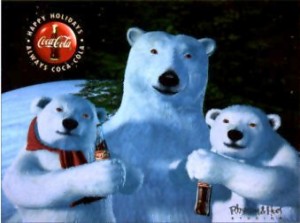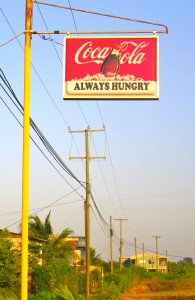It isn’t often that you come across a class that you get the opportunity to see the application of the theory that you learn in practice. The course project from Comm 296 gave that chance, following a company from a situational analysis, to segmenting, targeting and positioning and finally to making recommendations based on the company’s current marketing mix. Working in a team environment is always a struggle, between actually coming up with an actionable idea, dividing the work content and somehow integrating 5 different people’s writing styles and perspectives into a singular, holistic product, but this project was effective in demonstrating how a real marketing team would operate in the industry. For me, my largest takeaway from this marketing course was the disconnect that exists between a company’s product or service and advertisements that we see in day to day life; so much more is put into developing a marketing plan than coming up with a creative and engaging way to promote the product. The frameworks that I learned throughout this course solidify a step-by-step approach of how to develop a company’s marketing, and learning what I did I find myself criticizing advertisements and PR strategies that companies have employed that aren’t congruent with their target market, or don’t engage their consumers with the benefits their product offers. This critical eye is something I believe to be of the upmost importance in business, especially when industries are becoming increasingly competitive and brand awareness is crucial, so knowing how to capitalize on your competitor’s mistakes could be the key to success for many businesses. In the broadest sense, Comm 296 has shown me how true it is that “Business has only two functions – marketing and innovation.” (Milan Kundera)
that companies have employed that aren’t congruent with their target market, or don’t engage their consumers with the benefits their product offers. This critical eye is something I believe to be of the upmost importance in business, especially when industries are becoming increasingly competitive and brand awareness is crucial, so knowing how to capitalize on your competitor’s mistakes could be the key to success for many businesses. In the broadest sense, Comm 296 has shown me how true it is that “Business has only two functions – marketing and innovation.” (Milan Kundera)
It’s Miller Time
Ranked as the most watched On-Demand movie of all time, there’s a good chance that the majority of people that drink beer have seen The Hangover. This crossover in audiences was brought to my attention by Adland’s recent blog post about a Miller Lite commercial, during which comedian and actor Ken Jeong is identified as “that guy from that thing”. Since the beer industry is in the maturity stage of its life cycle – especially for well-established brands like Miller – this commercial can be seen as reminder advertising, reminding consumers that Miller Lite makes your life feel like Ken Jeong is a part of your posse. Largely capitalizing on celebrity identification, Miller Lite was able to tie the largely male dominated market for beer to a movie that similarly caters to males aged 18-24, a smart advertising move to remind consumers that the product is relevant to the target audience. Given that Miller Lite has already established the functional aspects of their product offering, they are relying on the emotional appeal of humor to further develop the bond that consumers experience with Miller Lite beer. More so, the Ken Jeong commercial ties right back into the longstanding campaign of “Miller Time”, which taglines “‘Miller Time’ is a simple equation. It’s guys who are great friends getting together and having a great beer, which happens to be Miller Lite.” This shows Miller Lite’s ability to maintain the effective components of the marketing mix that they are currently operating with, while integrating a novelty that adds relatability and comedy to their advertising. And really, who doesn’t want to see Ken Jeong dressed up in a sombrero and a fake moustache mentioning, “Sorry I’m late, I came straight from work.”
the bond that consumers experience with Miller Lite beer. More so, the Ken Jeong commercial ties right back into the longstanding campaign of “Miller Time”, which taglines “‘Miller Time’ is a simple equation. It’s guys who are great friends getting together and having a great beer, which happens to be Miller Lite.” This shows Miller Lite’s ability to maintain the effective components of the marketing mix that they are currently operating with, while integrating a novelty that adds relatability and comedy to their advertising. And really, who doesn’t want to see Ken Jeong dressed up in a sombrero and a fake moustache mentioning, “Sorry I’m late, I came straight from work.”
Social Media: A Blessing or a Curse?
When I came across Maddie Erjavec’s blog post about the impact of social media on brand marketing, I was surprised that a majority of the reviews written about companies were positive. Voluntary response channels, like social media, can be volatile as most users that comment on their experience with a brand will be the most strongly opinionated, whether that attitude be positive or negative. Perhaps the most dangerous part of social media as a tool for brand awareness is how uncontrollable it is, and how quickly it can spin out of the PR manager’s control, like was the case for Applebee’s recent Facebook meltdown. Public relations is often loosely defined as “spinning the story” to create positive publicity out of an unfavourable event, which Applebee’s attempted to 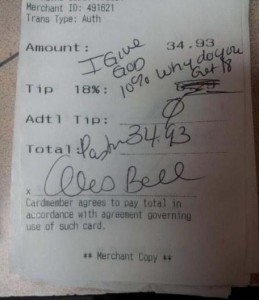 do in the wake of firing a waitress after she posted a picture of a receipt that a customer had left a snarky remark on, claiming that the waitress had violated the customer’s privacy. In a world where so much of our lives have become public property with the advances in technology and communication, Facebook users were outraged that the waitress was fired and began creating anti-Applebee’s boycotts and spamming the company’s Facebook page. In an attempt to appease the angry customers, whose comments were potentially causing them to lose a loyal consumer base, Applebee’s posted a status stating “We wish this situation didn’t happen…Our franchisee has apologized to the Guest and has taken disciplinary action with the Team Member for violating their Guest’s right to privacy.” This statement had exactly the opposite effect that Applebee’s PR team meant it to have, generating some
do in the wake of firing a waitress after she posted a picture of a receipt that a customer had left a snarky remark on, claiming that the waitress had violated the customer’s privacy. In a world where so much of our lives have become public property with the advances in technology and communication, Facebook users were outraged that the waitress was fired and began creating anti-Applebee’s boycotts and spamming the company’s Facebook page. In an attempt to appease the angry customers, whose comments were potentially causing them to lose a loyal consumer base, Applebee’s posted a status stating “We wish this situation didn’t happen…Our franchisee has apologized to the Guest and has taken disciplinary action with the Team Member for violating their Guest’s right to privacy.” This statement had exactly the opposite effect that Applebee’s PR team meant it to have, generating some 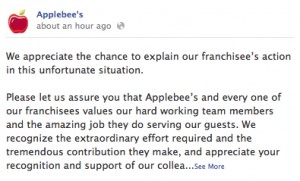 17,000 comments in less than 12 hours, at which point Applebee’s escalated the situation even further to began engaging with angry comments by tagging users and directly responding to their qualms. Although for getting brand recognition social media is effective, when opinions are uncensored and delivered in mass, companies like Applebee’s need to reshape their PR strategies to handle situations that can quickly spin out of control.
17,000 comments in less than 12 hours, at which point Applebee’s escalated the situation even further to began engaging with angry comments by tagging users and directly responding to their qualms. Although for getting brand recognition social media is effective, when opinions are uncensored and delivered in mass, companies like Applebee’s need to reshape their PR strategies to handle situations that can quickly spin out of control.
Part II: Branding an Entire Species
When asked to conjure an image that represents a brand, our culture is likely to think of logos or trademarks that are recognizable by their presence on many of the brand’s products, not an entire species of animals. The same can’t be said for Coca Cola, who has managed to integrate polar bears into a vital part of their brand image and advertising campaigns across the globe. Recently winning the Brand Icon Award from the CLIO Awards, Coca Cola was recognized for leveraging innovative advertising techniques to increase their brand equity. Coca Cola has used their polar bear campaign, which has been part of print-advertising since 1922, to “epitomize the cheerful, heart-warming atmosphere that Coca Cola is hoping to bring” to their consumers.
Teaming with the World Wildlife Fund, Coca Cola has reduced greenhouse gas emissions themselves, as well as promoted sustainable living by educating North Americans on climate change solutions. This initiative, which has largely differentiated Coca Cola from their main competitor Pepsi, shows the company’s concern for the environment, and more specifically how climate change will negatively impact their mascot, the polar bear. As providers of a convenience product that consumers are largely price  sensitive towards, having a brand that advocates for the extremely relevant social issue of sustainable living and preventing climate change will allow Coca Cola to capture consumers that are not strictly loyal to a specific soft drink company. Not only does Coca Cola hope to capitalize on corporate social responsibility, but they also hope to appeal to the psychographic aspects of the consumers that fosters a visceral reaction by relating polar bears to a sense of family and love. And that being said, after the animated commercials directed by famed Ridley Scott, one of which depicts an adorable family of polar bears building a “snow bear” together, who can resist buying a Coca Cola product that has the very same polar bear on the can?
sensitive towards, having a brand that advocates for the extremely relevant social issue of sustainable living and preventing climate change will allow Coca Cola to capture consumers that are not strictly loyal to a specific soft drink company. Not only does Coca Cola hope to capitalize on corporate social responsibility, but they also hope to appeal to the psychographic aspects of the consumers that fosters a visceral reaction by relating polar bears to a sense of family and love. And that being said, after the animated commercials directed by famed Ridley Scott, one of which depicts an adorable family of polar bears building a “snow bear” together, who can resist buying a Coca Cola product that has the very same polar bear on the can?
Part I: Who said Coca Cola’s Brand Image Doesn’t Include Palm Trees?
During my reading break, my family and I ventured to a minuscule town called Hopkins in southern Belize, a country home to cave tubing, the national animal called a tapir, the Mayan ruins of Caracol and Xunatunich, and ironically enough, Coca Cola that sells for less than a bottle of water. As I noticed a Coca Cola sign – and sometimes several – on almost every store front and home across the countryside, my research found that this year marks the 50th anniversary of Coca Cola’s monopoly in Belize, owned by sole bottler Bowen & Bowen, Ltd., whose founder became the second richest man in the country. As Belize, formerly known as British Honduras, became fully independent from the United Kingdom in 1964, the years prior were subject to economic and political turmoil between the PUP and UDP parties, a situation that allowed the local elite of Barry Bowen to acquire duty-free import concessions and tax exemptions that gave him the opportunity to build Bowen & Bowen Ltd. and gain a foothold as the primary distributor of Coca Cola. Commenting on a painting that he did for a contest celebrating Coca Cola’s 50th anniversary, a Belizean
sometimes several – on almost every store front and home across the countryside, my research found that this year marks the 50th anniversary of Coca Cola’s monopoly in Belize, owned by sole bottler Bowen & Bowen, Ltd., whose founder became the second richest man in the country. As Belize, formerly known as British Honduras, became fully independent from the United Kingdom in 1964, the years prior were subject to economic and political turmoil between the PUP and UDP parties, a situation that allowed the local elite of Barry Bowen to acquire duty-free import concessions and tax exemptions that gave him the opportunity to build Bowen & Bowen Ltd. and gain a foothold as the primary distributor of Coca Cola. Commenting on a painting that he did for a contest celebrating Coca Cola’s 50th anniversary, a Belizean 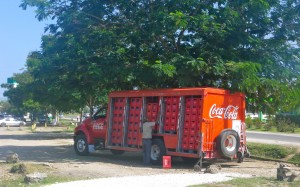 high school student quoted that, “Everyday, we see Belizeans after work, they go to drink a Coke. During dinner or lunch, they would also drink Coke […] it’s culture and tradition.”
high school student quoted that, “Everyday, we see Belizeans after work, they go to drink a Coke. During dinner or lunch, they would also drink Coke […] it’s culture and tradition.”
l
Within the context of North America, Coca Cola has been extremely successful in developing brand equity of such strength in a highly competitive industry, most notably against their most direct counterpart of Pepsi; however, being the only soft drink available in Belize, Coca Cola managed to integrate themselves into the culture of Belizeans, and generate a visceral, loyal reaction to their product. Although it is much easier to gain traction in an industry with no competition, Coca Cola positioned itself within the market to be accessible and identifiable with all aspects of Belizean life, making their product something of an expectation as a purchase, rather than a choice.
Coca Cola was a little taste of home during my trip to Belize, but that being said, nothing beats sitting on the beach with one of Bowen & Bowen Ltd.’s more local monopolies… Belikin (or as we like to say, Be Likin’) beer.
BlackBerry Falling Behind in the Third Quarter
“In 30 seconds, it’s quicker to show you what it can’t do.” This was the slogan for the BlackBerry Z10 Super Bowl commercial, which was part of the second phase of a marketing strategy to reinvent the lagging smartphone contender. The company previously known as Research in Motion Ltd. has rebranded itself to hopefully attract consumers that identify with its primary product, and hence RIM became BlackBerry on January 30, 2013. Following a statement from the Chief Marketing Officer, Frank Boulben, stating that marketing success will be based on organic word-of-mouth buzz for its new product, BlackBerry has unveiled a three stage marketing plan to refresh their image and gain back consumer loyalty after losing much of their sales to Apple’s iPhone and Samsung Androids. In Phase 1, BlackBerry’s main goal was to generate talk about what the new BlackBerry operating system is capable of, so face-to-face demonstrations were given to influential people within the industry and public figures. This was followed up with Phase 2, a video-based platform that will encourage viewers to go online and see what BlackBerry is going  to offer next, the largest promotion for which was the aforementioned Super Bowl commercial which ran during the third quarter on Sunday. Their marketing plan will conclude with an initiative called “Keep Moving” which will document creative projects being supplemented by the technology available with the new BlackBerry 10 operating system, spearheaded most notably by singer Alicia Keys. Although BlackBerry’s marketing strategy is comprehensive in that it targets a broad audience, the company has a lot of ground to make up in the smartphone industry, which is more likely to be taken with customer loyalty rather than replication of product capabilities. With such a lock on the full QWERTY keyboard market, perhaps BlackBerry should be focussing on capitalizing on their place within the corporate world instead of chasing after an audience for personal smartphones that is seemingly dominated by Apple and Samsung.
to offer next, the largest promotion for which was the aforementioned Super Bowl commercial which ran during the third quarter on Sunday. Their marketing plan will conclude with an initiative called “Keep Moving” which will document creative projects being supplemented by the technology available with the new BlackBerry 10 operating system, spearheaded most notably by singer Alicia Keys. Although BlackBerry’s marketing strategy is comprehensive in that it targets a broad audience, the company has a lot of ground to make up in the smartphone industry, which is more likely to be taken with customer loyalty rather than replication of product capabilities. With such a lock on the full QWERTY keyboard market, perhaps BlackBerry should be focussing on capitalizing on their place within the corporate world instead of chasing after an audience for personal smartphones that is seemingly dominated by Apple and Samsung.
Time to Trash the Ash?
For the first time in decades, consumers may be surprised to see a commercial advertising smoking cigarettes, but not quite in the way you would expect – we won’t be seeing a revival of the Malboro Man anytime soon. In the midst of a social trend towards healthy living, in which you’re expected to carry a yoga mat everywhere, even the unhealthiest of habits have been converted; hence, the e-Cigarette.  A relatively new innovation, the e-Cigarette is tobacco free, unlike a traditional cigarette, and instead vaporizes nicotine and enables smokers to have a puff anywhere, at anytime. Marketers have capitalized on the ability to bend the rules of the Tobacco Control Act and promote smoking, since the e-Cigarette doesn’t technically qualify under legislation as a tobacco product. That being said, Harvard Medical School notes that several carcinogens and toxic chemicals common to traditional cigarettes can be found in significant dosage in the e-Cigarette, raising the concern that advertisements claiming the e-Cigarette is a safe alternative to smoking are simply a money grab to exploit the segment of the population that may have already quit smoking or are looking for a reason to begin. Offering e-Cigarettes that come in hot pink and are shaped like lipstick, it is obvious which untapped market campaigns are targeting; marketers have found a way to bridge the gap between smoking and youth via endorsements from celebrities popular with Generation Y like DJ Heavy Grinder and actor Stephen Dorff.
A relatively new innovation, the e-Cigarette is tobacco free, unlike a traditional cigarette, and instead vaporizes nicotine and enables smokers to have a puff anywhere, at anytime. Marketers have capitalized on the ability to bend the rules of the Tobacco Control Act and promote smoking, since the e-Cigarette doesn’t technically qualify under legislation as a tobacco product. That being said, Harvard Medical School notes that several carcinogens and toxic chemicals common to traditional cigarettes can be found in significant dosage in the e-Cigarette, raising the concern that advertisements claiming the e-Cigarette is a safe alternative to smoking are simply a money grab to exploit the segment of the population that may have already quit smoking or are looking for a reason to begin. Offering e-Cigarettes that come in hot pink and are shaped like lipstick, it is obvious which untapped market campaigns are targeting; marketers have found a way to bridge the gap between smoking and youth via endorsements from celebrities popular with Generation Y like DJ Heavy Grinder and actor Stephen Dorff.
Mirroring the themes that created such appeal for tobacco cigarette brands, marketing for the e-Cigarette has gained momentous traction and is showing no sign of slowing down, captivating smokers and non-smokers alike. Although there is something to be said for the lack of tobacco, it calls to attention whether promotion of this product is really just putting a bandaid over a bullet wound.

